warning light NISSAN ALTIMA 2005 L31 / 3.G Owners Manual
[x] Cancel search | Manufacturer: NISSAN, Model Year: 2005, Model line: ALTIMA, Model: NISSAN ALTIMA 2005 L31 / 3.GPages: 304, PDF Size: 4.91 MB
Page 7 of 304
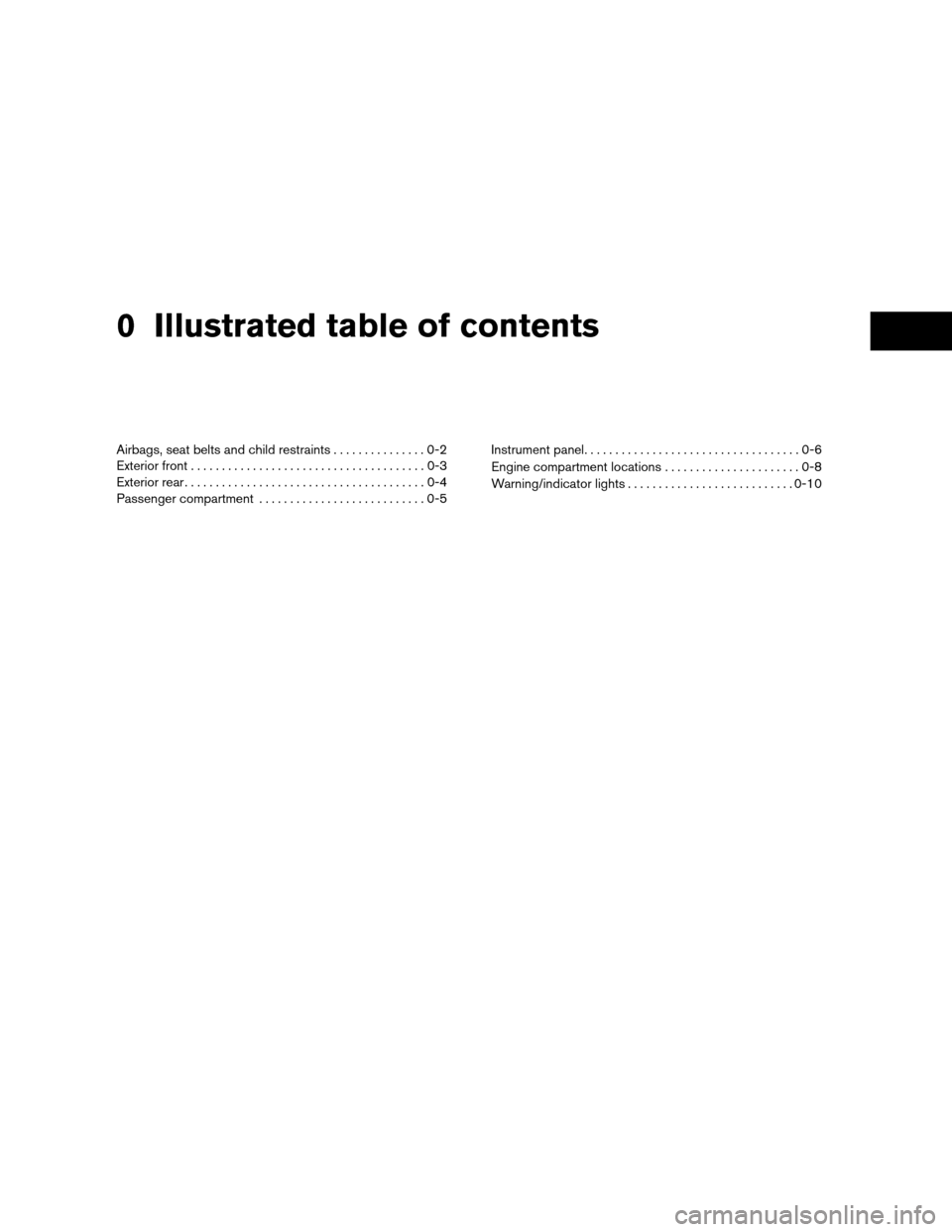
0 Illustrated table of contents
Airbags, seat belts and child restraints...............0-2
Exterior front ......................................0-3
Exterior rear .......................................0-4
Passenger compartment ...........................0-5 Instrument panel
...................................0-6
Engine compartment locations ......................0-8
Warning/indicator lights ........................... 0-10
ZREVIEW COPYÐ2005 Altima(l30)
Owners ManualÐUSA_English (nna)
06/29/04Ðtbrooks
X
Page 12 of 304
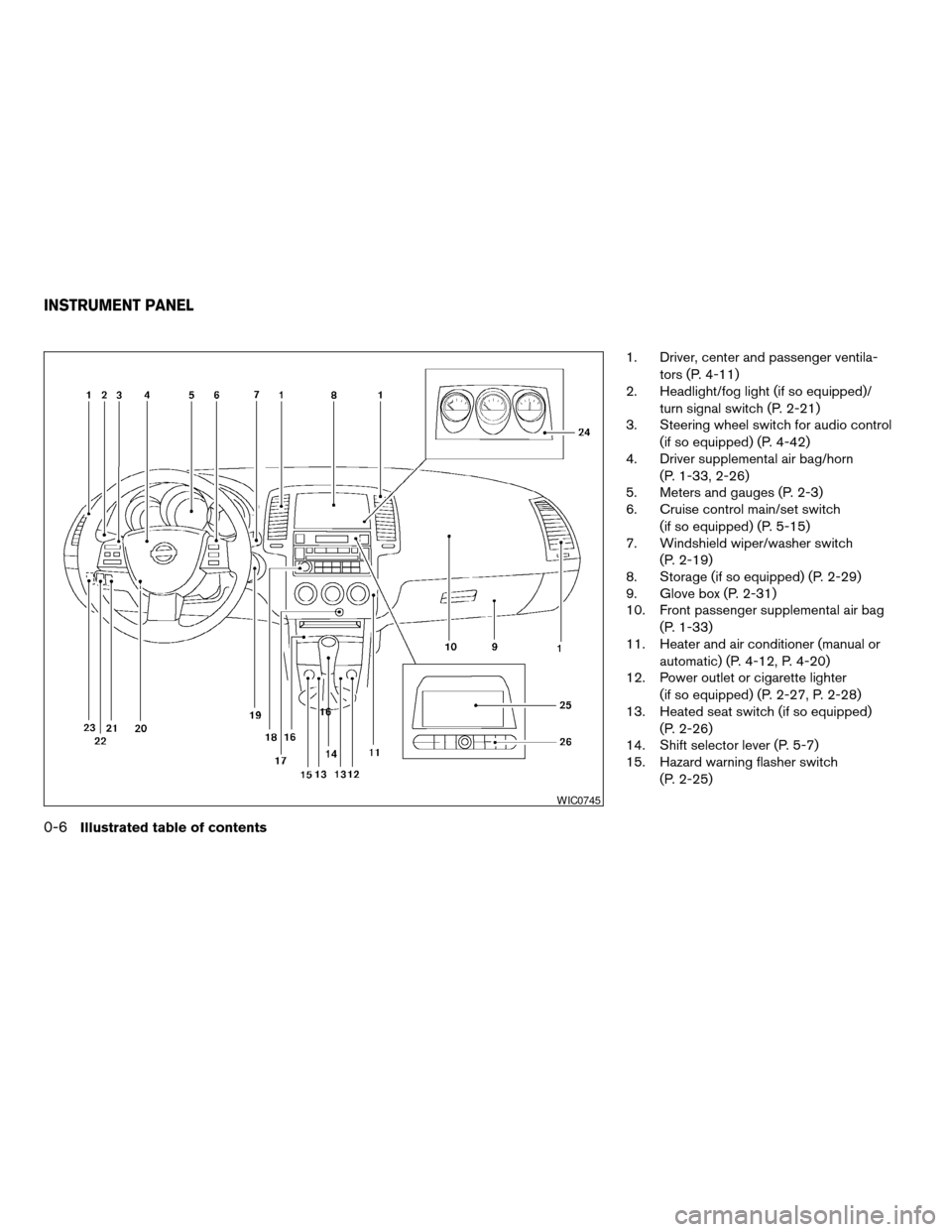
1. Driver, center and passenger ventila-tors (P. 4-11)
2. Headlight/fog light (if so equipped)/
turn signal switch (P. 2-21)
3. Steering wheel switch for audio control
(if so equipped) (P. 4-42)
4. Driver supplemental air bag/horn
(P. 1-33, 2-26)
5. Meters and gauges (P. 2-3)
6. Cruise control main/set switch
(if so equipped) (P. 5-15)
7. Windshield wiper/washer switch
(P. 2-19)
8. Storage (if so equipped) (P. 2-29)
9. Glove box (P. 2-31)
10. Front passenger supplemental air bag
(P. 1-33)
11. Heater and air conditioner (manual or
automatic) (P. 4-12, P. 4-20)
12. Power outlet or cigarette lighter
(if so equipped) (P. 2-27, P. 2-28)
13. Heated seat switch (if so equipped)
(P. 2-26)
14. Shift selector lever (P. 5-7)
15. Hazard warning flasher switch
(P. 2-25)
WIC0745
INSTRUMENT PANEL
0-6Illustrated table of contents
ZREVIEW COPYÐ2005 Altima (l30)
Owners ManualÐUSA_English (nna)
07/09/04Ðbetty
X
Page 16 of 304
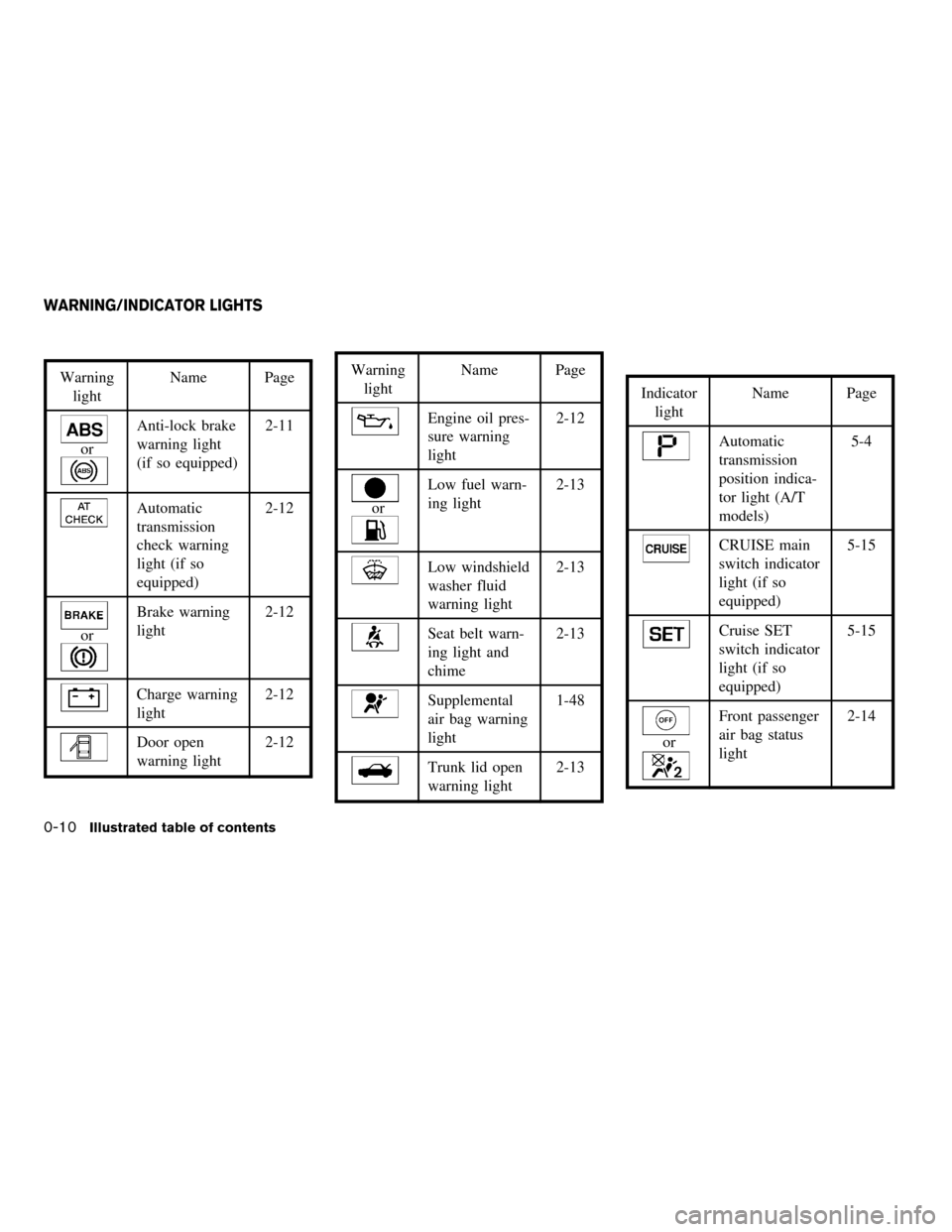
Warninglight Name Page
or
Anti-lock brake
warning light
(if so equipped) 2-11
Automatic
transmission
check warning
light (if so
equipped)2-12
or
Brake warning
light
2-12
Charge warning
light2-12
Door open
warning light2-12
Warning
light Name Page
Engine oil pres-
sure warning
light 2-12
or
Low fuel warn-
ing light
2-13
Low windshield
washer fluid
warning light2-13
Seat belt warn-
ing light and
chime2-13
Supplemental
air bag warning
light1-48
Trunk lid open
warning light
2-13
Indicator
light Name Page
Automatic
transmission
position indica-
tor light (A/T
models) 5-4
CRUISE main
switch indicator
light (if so
equipped)
5-15
Cruise SET
switch indicator
light (if so
equipped)5-15
or
Front passenger
air bag status
light
2-14
WARNING/INDICATOR LIGHTS
0-10Illustrated table of contents
ZREVIEW COPYÐ2005 Altima
(l30)
Owners ManualÐUSA_English (nna)
06/29/04Ðtbrooks
X
Page 19 of 304
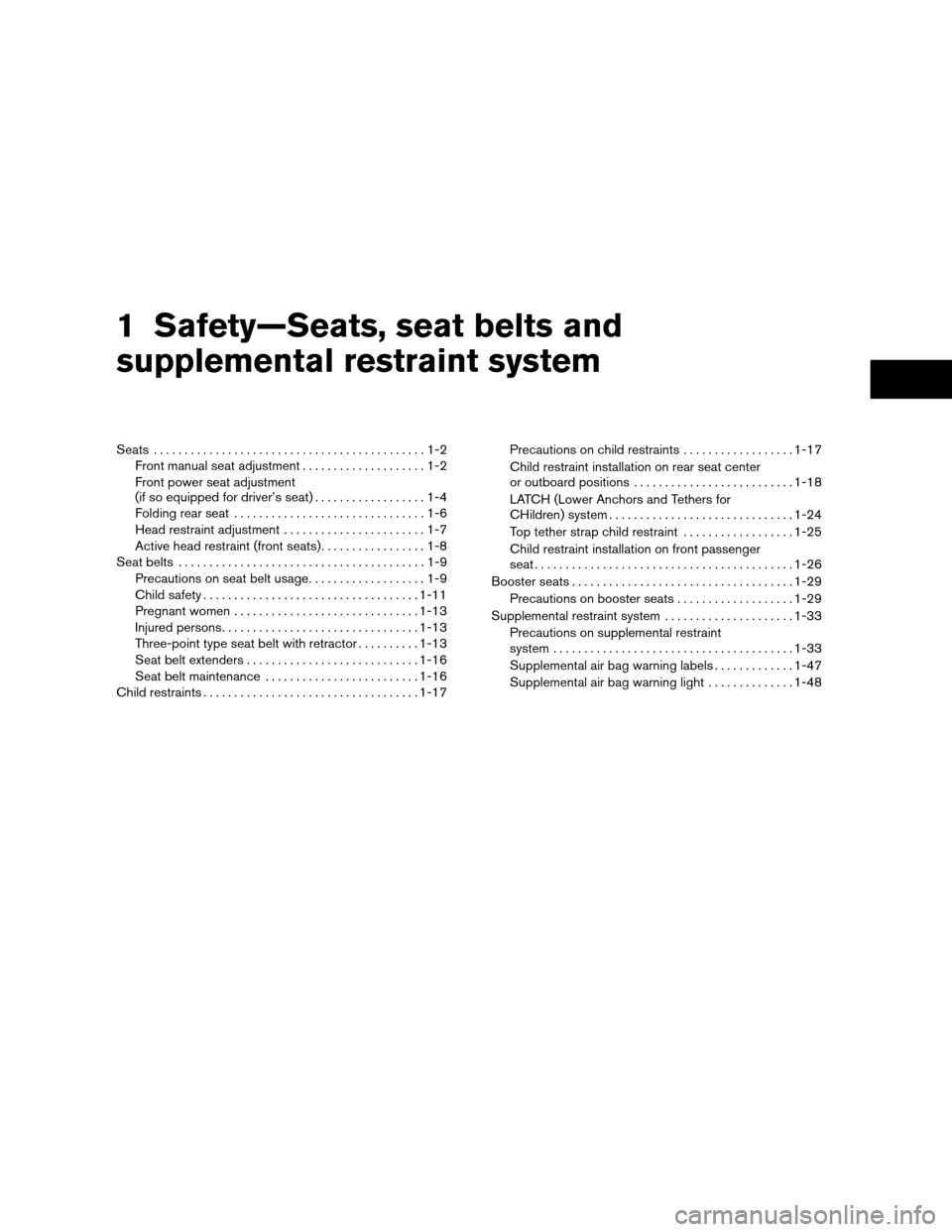
1 Safety—Seats, seat belts and
supplemental restraint system
Seats............................................1-2
Front manual seat adjustment ....................1-2
Front power seat adjustment
(if so equipped for driver’s seat) ..................1-4
Folding rear seat ...............................1-6
Head restraint adjustment .......................1-7
Active head restraint (front seats) .................1-8
Seat belts ........................................1-9
Precautions on seat belt usage ...................1-9
Child safety ................................... 1-11
Pregnant women .............................. 1-13
Injured persons ................................ 1-13
Three-point type seat belt with retractor ..........1-13
Seat belt extenders ............................ 1-16
Seat belt maintenance ......................... 1-16
Child restraints ................................... 1-17Precautions on child restraints
..................1-17
Child restraint installation on rear seat center
or outboard positions .......................... 1-18
LATCH (Lower Anchors and Tethers for
CHildren) system .............................. 1-24
Top tether strap child restraint ..................1-25
Child restraint installation on front passenger
seat .......................................... 1-26
Booster seats .................................... 1-29
Precautions on booster seats ...................1-29
Supplemental restraint system .....................1-33
Precautions on supplemental restraint
system ....................................... 1-33
Supplemental air bag warning labels .............1-47
Supplemental air bag warning light ..............1-48
ZREVIEW COPYÐ2005 Altima(l30)
Owners ManualÐUSA_English (nna)
06/29/04Ðtbrooks
X
Page 29 of 304
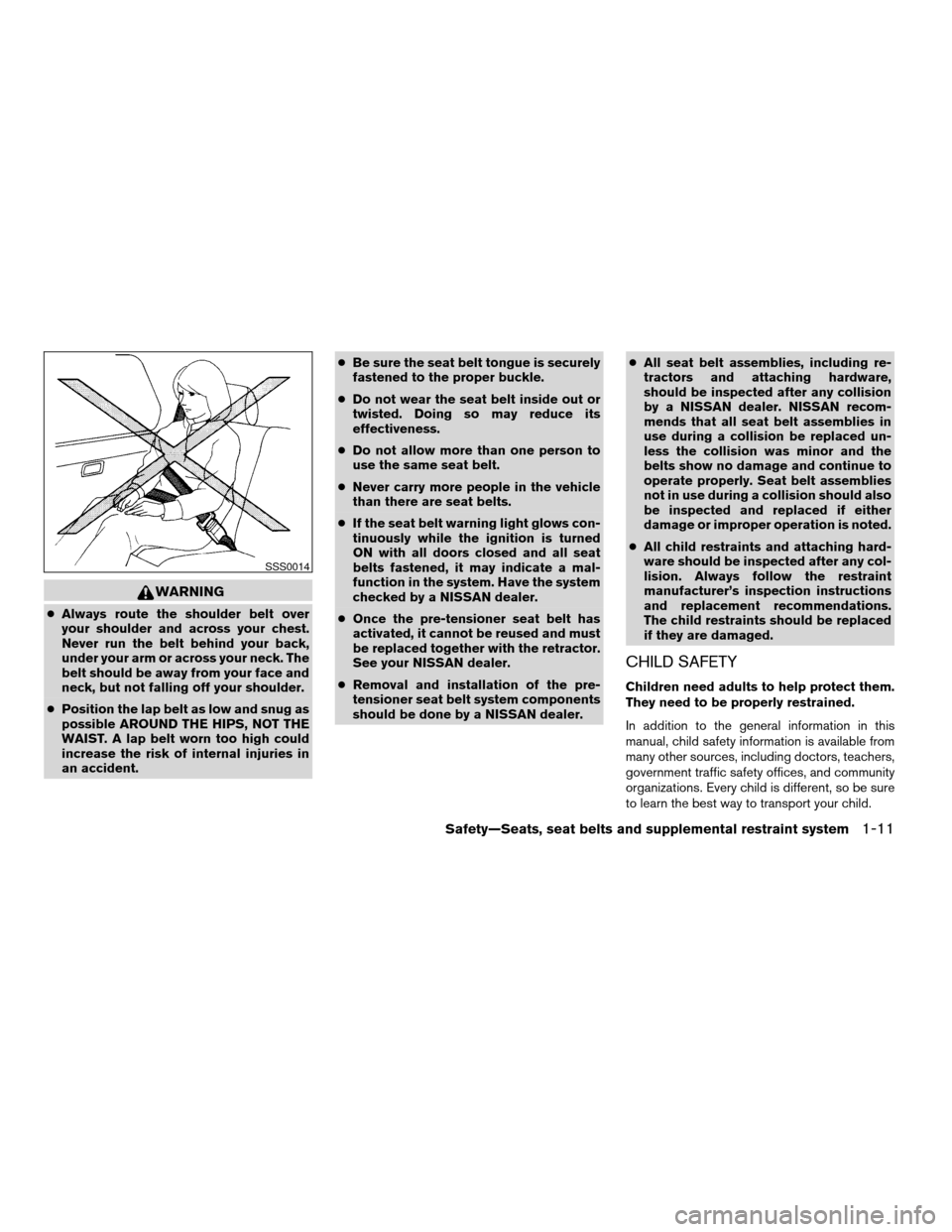
WARNING
cAlways route the shoulder belt over
your shoulder and across your chest.
Never run the belt behind your back,
under your arm or across your neck. The
belt should be away from your face and
neck, but not falling off your shoulder.
c Position the lap belt as low and snug as
possible AROUND THE HIPS, NOT THE
WAIST. A lap belt worn too high could
increase the risk of internal injuries in
an accident. c
Be sure the seat belt tongue is securely
fastened to the proper buckle.
c Do not wear the seat belt inside out or
twisted. Doing so may reduce its
effectiveness.
c Do not allow more than one person to
use the same seat belt.
c Never carry more people in the vehicle
than there are seat belts.
c If the seat belt warning light glows con-
tinuously while the ignition is turned
ON with all doors closed and all seat
belts fastened, it may indicate a mal-
function in the system. Have the system
checked by a NISSAN dealer.
c Once the pre-tensioner seat belt has
activated, it cannot be reused and must
be replaced together with the retractor.
See your NISSAN dealer.
c Removal and installation of the pre-
tensioner seat belt system components
should be done by a NISSAN dealer. c
All seat belt assemblies, including re-
tractors and attaching hardware,
should be inspected after any collision
by a NISSAN dealer. NISSAN recom-
mends that all seat belt assemblies in
use during a collision be replaced un-
less the collision was minor and the
belts show no damage and continue to
operate properly. Seat belt assemblies
not in use during a collision should also
be inspected and replaced if either
damage or improper operation is noted.
c All child restraints and attaching hard-
ware should be inspected after any col-
lision. Always follow the restraint
manufacturer’s inspection instructions
and replacement recommendations.
The child restraints should be replaced
if they are damaged.
CHILD SAFETY
Children need adults to help protect them.
They need to be properly restrained.
In addition to the general information in this
manual, child safety information is available from
many other sources, including doctors, teachers,
government traffic safety offices, and community
organizations. Every child is different, so be sure
to learn the best way to transport your child.
SSS0014
Safety—Seats, seat belts and supplemental restraint system1-11
ZREVIEW COPYÐ2005 Altima (l30)
Owners ManualÐUSA_English (nna)
06/28/04Ðtbrooks
X
Page 44 of 304
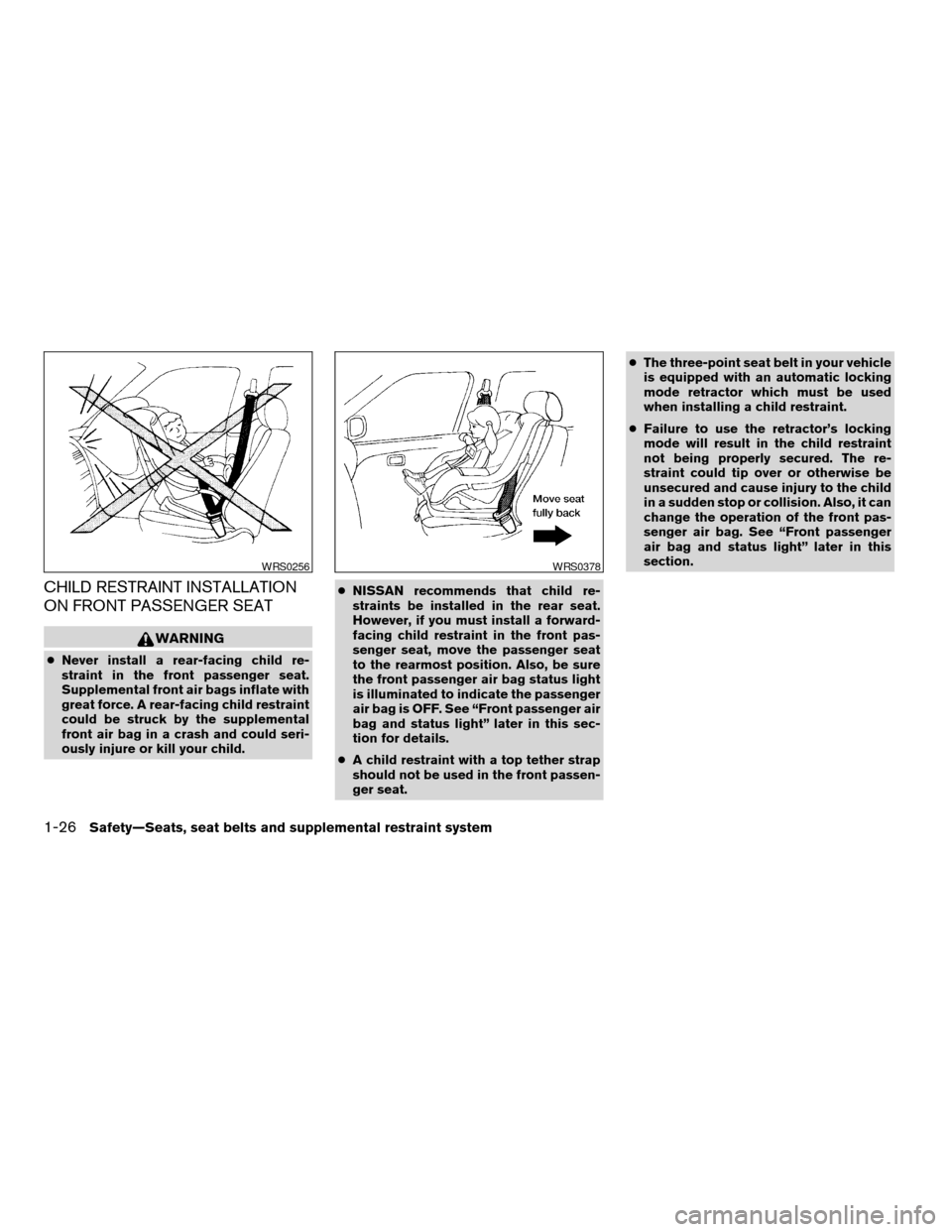
CHILD RESTRAINT INSTALLATION
ON FRONT PASSENGER SEAT
WARNING
cNever install a rear-facing child re-
straint in the front passenger seat.
Supplemental front air bags inflate with
great force. A rear-facing child restraint
could be struck by the supplemental
front air bag in a crash and could seri-
ously injure or kill your child. c
NISSAN recommends that child re-
straints be installed in the rear seat.
However, if you must install a forward-
facing child restraint in the front pas-
senger seat, move the passenger seat
to the rearmost position. Also, be sure
the front passenger air bag status light
is illuminated to indicate the passenger
air bag is OFF. See “Front passenger air
bag and status light” later in this sec-
tion for details.
c A child restraint with a top tether strap
should not be used in the front passen-
ger seat. c
The three-point seat belt in your vehicle
is equipped with an automatic locking
mode retractor which must be used
when installing a child restraint.
c Failure to use the retractor’s locking
mode will result in the child restraint
not being properly secured. The re-
straint could tip over or otherwise be
unsecured and cause injury to the child
in a sudden stop or collision. Also, it can
change the operation of the front pas-
senger air bag. See “Front passenger
air bag and status light” later in this
section.
WRS0256WRS0378
1-26Safety—Seats, seat belts and supplemental restraint system
ZREVIEW COPYÐ2005 Altima (l30)
Owners ManualÐUSA_English (nna)
08/23/04Ðarosenma
X
Page 47 of 304
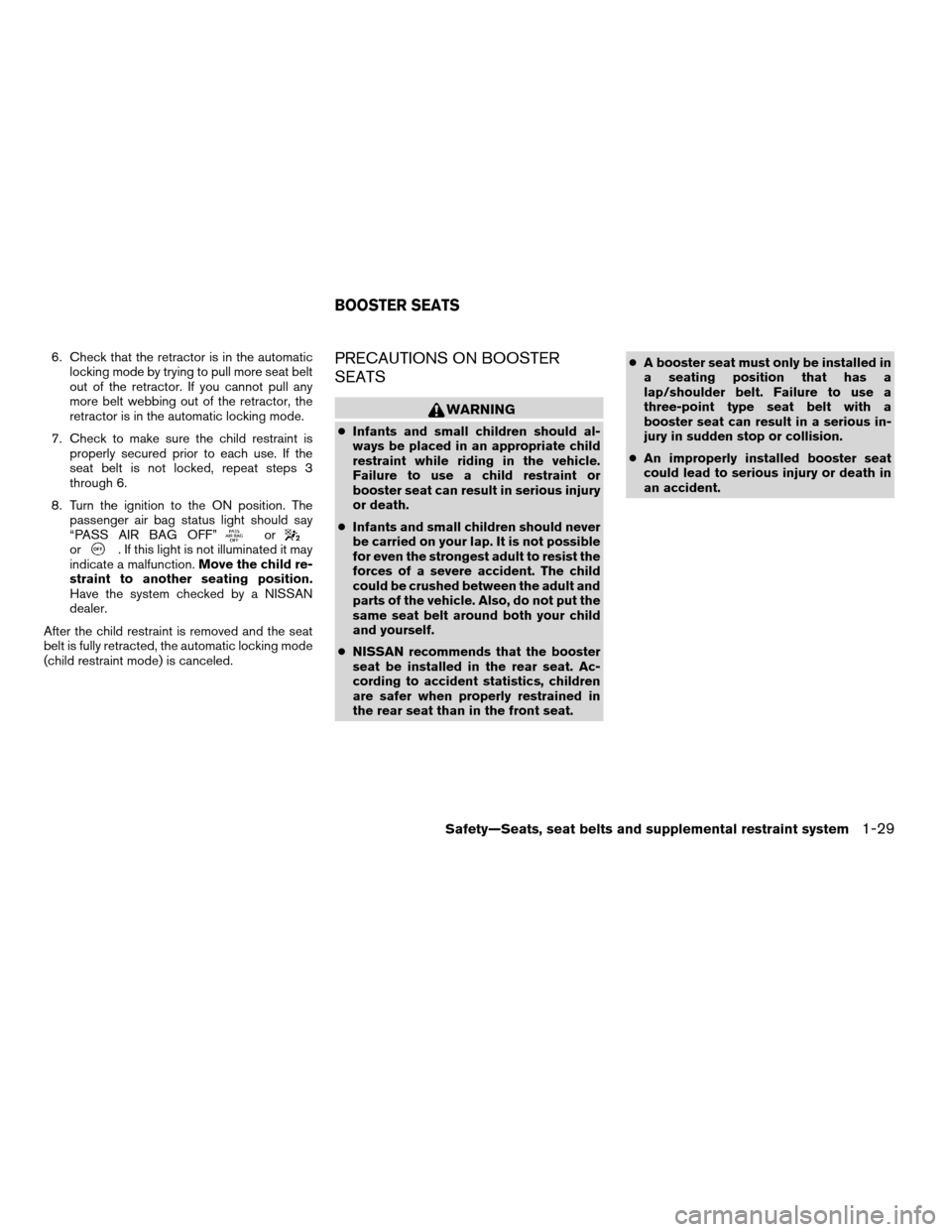
6. Check that the retractor is in the automaticlocking mode by trying to pull more seat belt
out of the retractor. If you cannot pull any
more belt webbing out of the retractor, the
retractor is in the automatic locking mode.
7. Check to make sure the child restraint is properly secured prior to each use. If the
seat belt is not locked, repeat steps 3
through 6.
8. Turn the ignition to the ON position. The passenger air bag status light should say
“PASS AIR BAG OFF”
oror. If this light is not illuminated it may
indicate a malfunction. Move the child re-
straint to another seating position.
Have the system checked by a NISSAN
dealer.
After the child restraint is removed and the seat
belt is fully retracted, the automatic locking mode
(child restraint mode) is canceled.
PRECAUTIONS ON BOOSTER
SEATS
WARNING
c Infants and small children should al-
ways be placed in an appropriate child
restraint while riding in the vehicle.
Failure to use a child restraint or
booster seat can result in serious injury
or death.
c Infants and small children should never
be carried on your lap. It is not possible
for even the strongest adult to resist the
forces of a severe accident. The child
could be crushed between the adult and
parts of the vehicle. Also, do not put the
same seat belt around both your child
and yourself.
c NISSAN recommends that the booster
seat be installed in the rear seat. Ac-
cording to accident statistics, children
are safer when properly restrained in
the rear seat than in the front seat. c
A booster seat must only be installed in
a seating position that has a
lap/shoulder belt. Failure to use a
three-point type seat belt with a
booster seat can result in a serious in-
jury in sudden stop or collision.
c An improperly installed booster seat
could lead to serious injury or death in
an accident.
BOOSTER SEATS
Safety—Seats, seat belts and supplemental restraint system1-29
ZREVIEW COPYÐ2005 Altima (l30)
Owners ManualÐUSA_English (nna)
08/23/04Ðarosenma
X
Page 52 of 304
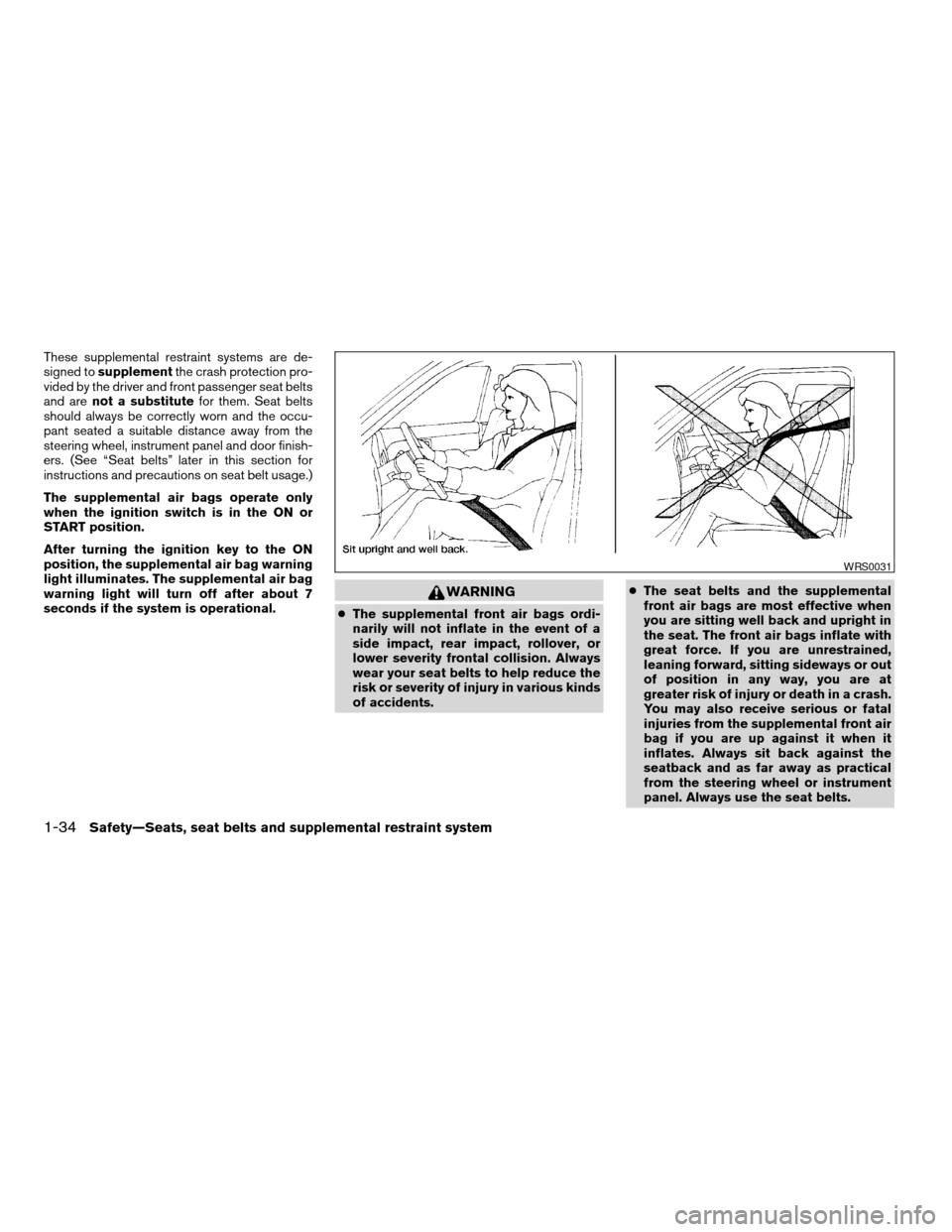
These supplemental restraint systems are de-
signed tosupplement the crash protection pro-
vided by the driver and front passenger seat belts
and are not a substitute for them. Seat belts
should always be correctly worn and the occu-
pant seated a suitable distance away from the
steering wheel, instrument panel and door finish-
ers. (See “Seat belts” later in this section for
instructions and precautions on seat belt usage.)
The supplemental air bags operate only
when the ignition switch is in the ON or
START position.
After turning the ignition key to the ON
position, the supplemental air bag warning
light illuminates. The supplemental air bag
warning light will turn off after about 7
seconds if the system is operational.
WARNING
c The supplemental front air bags ordi-
narily will not inflate in the event of a
side impact, rear impact, rollover, or
lower severity frontal collision. Always
wear your seat belts to help reduce the
risk or severity of injury in various kinds
of accidents. c
The seat belts and the supplemental
front air bags are most effective when
you are sitting well back and upright in
the seat. The front air bags inflate with
great force. If you are unrestrained,
leaning forward, sitting sideways or out
of position in any way, you are at
greater risk of injury or death in a crash.
You may also receive serious or fatal
injuries from the supplemental front air
bag if you are up against it when it
inflates. Always sit back against the
seatback and as far away as practical
from the steering wheel or instrument
panel. Always use the seat belts.
WRS0031
1-34Safety—Seats, seat belts and supplemental restraint system
ZREVIEW COPYÐ2005 Altima (l30)
Owners ManualÐUSA_English (nna)
06/28/04Ðtbrooks
X
Page 59 of 304
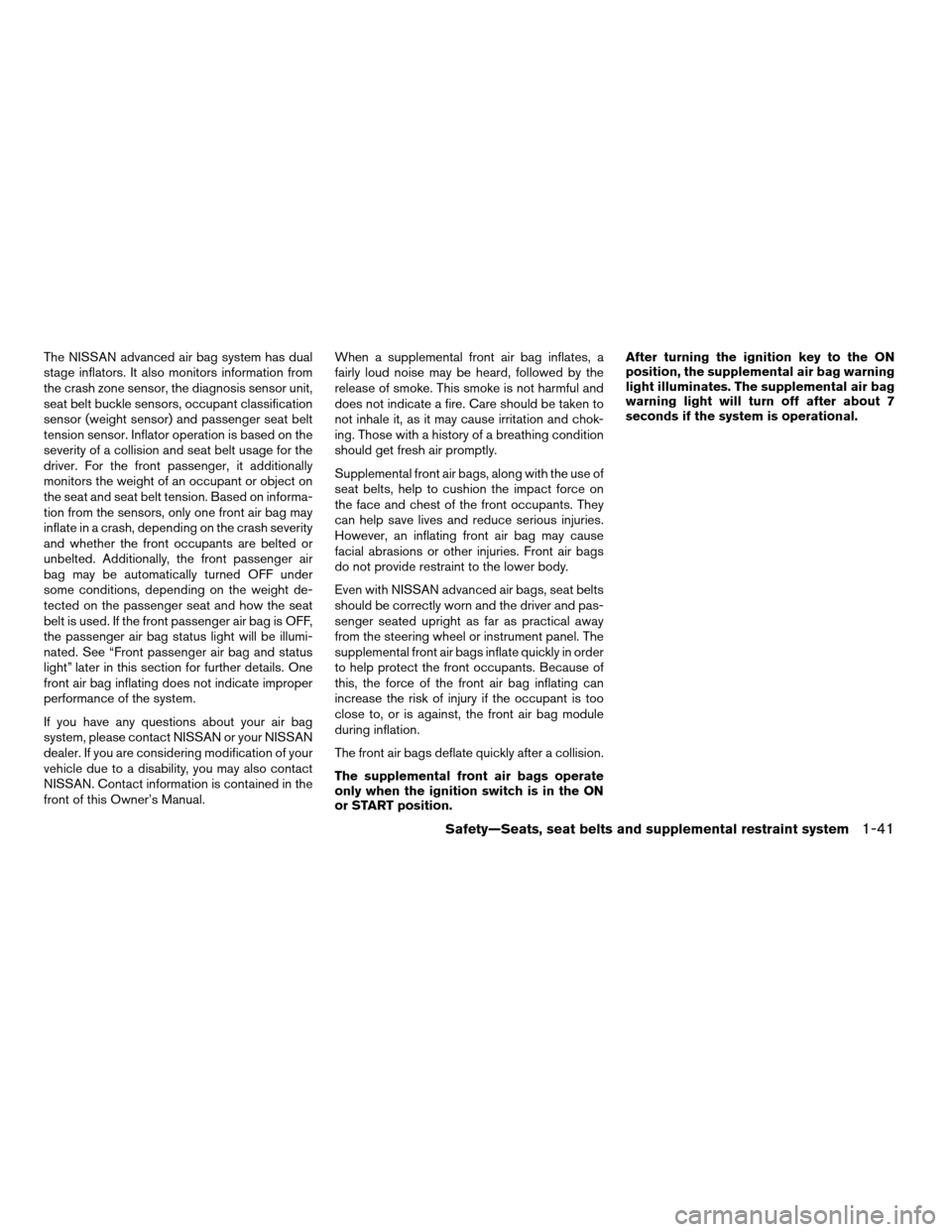
The NISSAN advanced air bag system has dual
stage inflators. It also monitors information from
the crash zone sensor, the diagnosis sensor unit,
seat belt buckle sensors, occupant classification
sensor (weight sensor) and passenger seat belt
tension sensor. Inflator operation is based on the
severity of a collision and seat belt usage for the
driver. For the front passenger, it additionally
monitors the weight of an occupant or object on
the seat and seat belt tension. Based on informa-
tion from the sensors, only one front air bag may
inflate in a crash, depending on the crash severity
and whether the front occupants are belted or
unbelted. Additionally, the front passenger air
bag may be automatically turned OFF under
some conditions, depending on the weight de-
tected on the passenger seat and how the seat
belt is used. If the front passenger air bag is OFF,
the passenger air bag status light will be illumi-
nated. See “Front passenger air bag and status
light” later in this section for further details. One
front air bag inflating does not indicate improper
performance of the system.
If you have any questions about your air bag
system, please contact NISSAN or your NISSAN
dealer. If you are considering modification of your
vehicle due to a disability, you may also contact
NISSAN. Contact information is contained in the
front of this Owner’s Manual.When a supplemental front air bag inflates, a
fairly loud noise may be heard, followed by the
release of smoke. This smoke is not harmful and
does not indicate a fire. Care should be taken to
not inhale it, as it may cause irritation and chok-
ing. Those with a history of a breathing condition
should get fresh air promptly.
Supplemental front air bags, along with the use of
seat belts, help to cushion the impact force on
the face and chest of the front occupants. They
can help save lives and reduce serious injuries.
However, an inflating front air bag may cause
facial abrasions or other injuries. Front air bags
do not provide restraint to the lower body.
Even with NISSAN advanced air bags, seat belts
should be correctly worn and the driver and pas-
senger seated upright as far as practical away
from the steering wheel or instrument panel. The
supplemental front air bags inflate quickly in order
to help protect the front occupants. Because of
this, the force of the front air bag inflating can
increase the risk of injury if the occupant is too
close to, or is against, the front air bag module
during inflation.
The front air bags deflate quickly after a collision.
The supplemental front air bags operate
only when the ignition switch is in the ON
or START position.After turning the ignition key to the ON
position, the supplemental air bag warning
light illuminates. The supplemental air bag
warning light will turn off after about 7
seconds if the system is operational.
Safety—Seats, seat belts and supplemental restraint system1-41
ZREVIEW COPYÐ2005 Altima
(l30)
Owners ManualÐUSA_English (nna)
06/28/04Ðtbrooks
X
Page 60 of 304
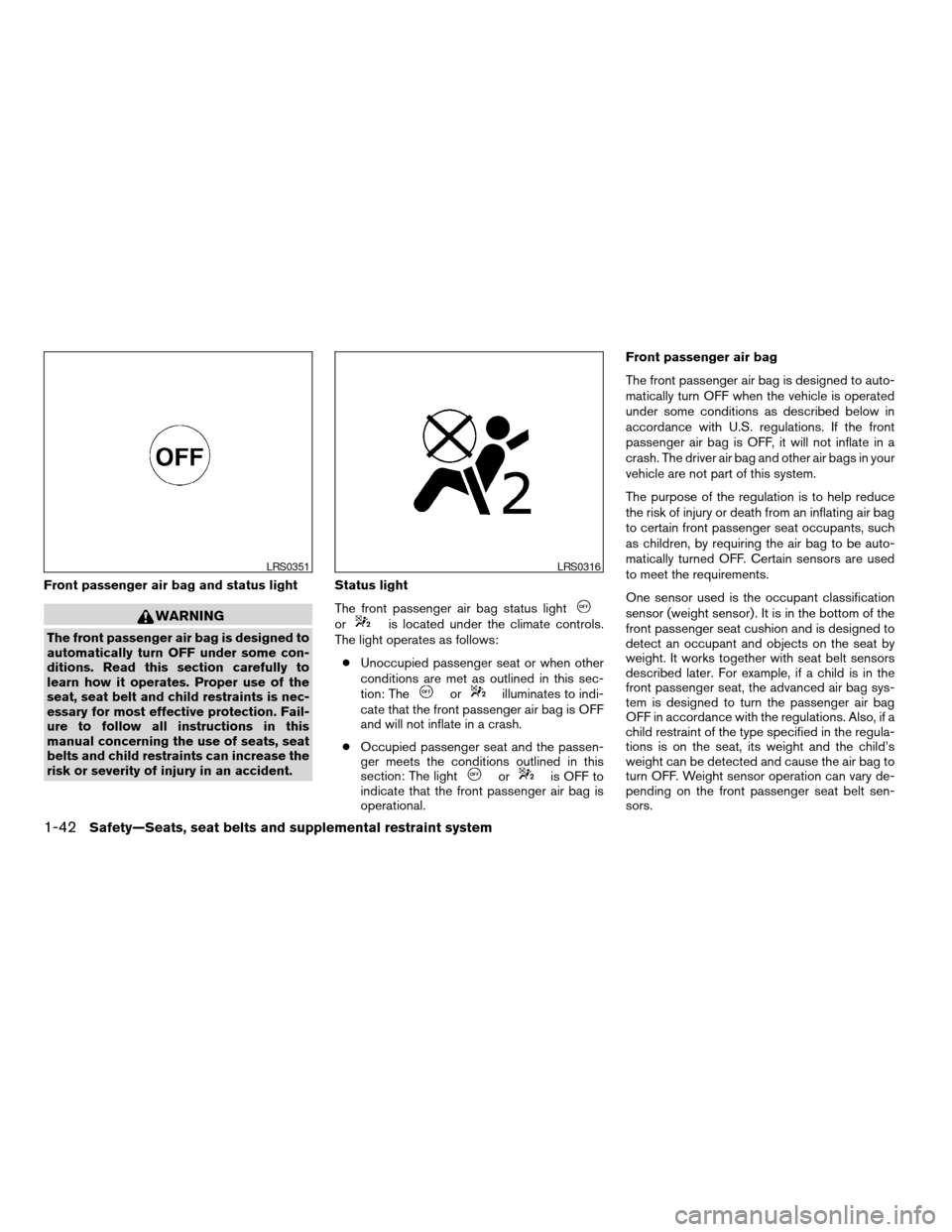
Front passenger air bag and status light
WARNING
The front passenger air bag is designed to
automatically turn OFF under some con-
ditions. Read this section carefully to
learn how it operates. Proper use of the
seat, seat belt and child restraints is nec-
essary for most effective protection. Fail-
ure to follow all instructions in this
manual concerning the use of seats, seat
belts and child restraints can increase the
risk or severity of injury in an accident.Status light
The front passenger air bag status lightoris located under the climate controls.
The light operates as follows:
c Unoccupied passenger seat or when other
conditions are met as outlined in this sec-
tion: The
orilluminates to indi-
cate that the front passenger air bag is OFF
and will not inflate in a crash.
c Occupied passenger seat and the passen-
ger meets the conditions outlined in this
section: The light
oris OFF to
indicate that the front passenger air bag is
operational. Front passenger air bag
The front passenger air bag is designed to auto-
matically turn OFF when the vehicle is operated
under some conditions as described below in
accordance with U.S. regulations. If the front
passenger air bag is OFF, it will not inflate in a
crash. The driver air bag and other air bags in your
vehicle are not part of this system.
The purpose of the regulation is to help reduce
the risk of injury or death from an inflating air bag
to certain front passenger seat occupants, such
as children, by requiring the air bag to be auto-
matically turned OFF. Certain sensors are used
to meet the requirements.
One sensor used is the occupant classification
sensor (weight sensor) . It is in the bottom of the
front passenger seat cushion and is designed to
detect an occupant and objects on the seat by
weight. It works together with seat belt sensors
described later. For example, if a child is in the
front passenger seat, the advanced air bag sys-
tem is designed to turn the passenger air bag
OFF in accordance with the regulations. Also, if a
child restraint of the type specified in the regula-
tions is on the seat, its weight and the child’s
weight can be detected and cause the air bag to
turn OFF. Weight sensor operation can vary de-
pending on the front passenger seat belt sen-
sors.
LRS0351LRS0316
1-42Safety—Seats, seat belts and supplemental restraint system
ZREVIEW COPYÐ2005 Altima
(l30)
Owners ManualÐUSA_English (nna)
06/28/04Ðtbrooks
X